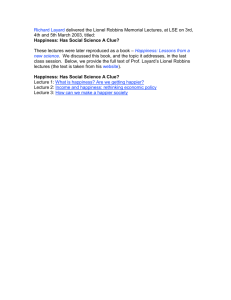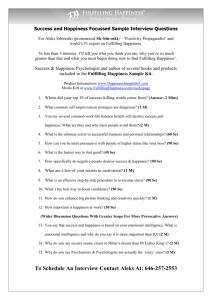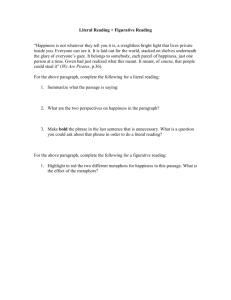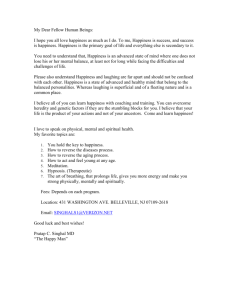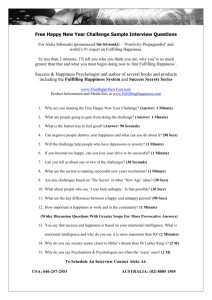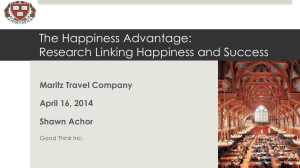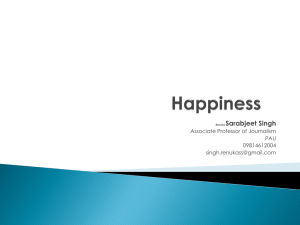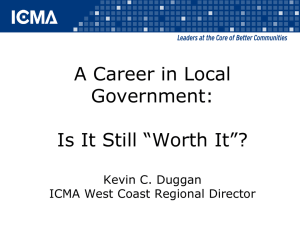Langer and Rodin
advertisement
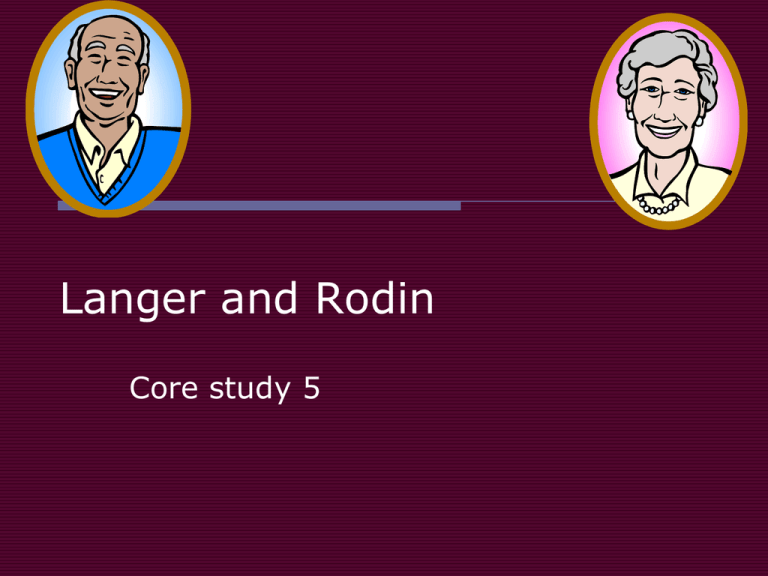
Langer and Rodin Core study 5 Context What is control? What things do you have control over? How much control do you have over your life? Is control important? Can too much or too little control be bad? Context Old age Loss of health and psychological function. Are these losses as part of a biological process, or the environment and social factors? For example, as a person gets older, they may experience a loss of roles and a decreased sense of responsibility. For example… Context Old people may feel a lack of control Neugarten and Gutman (1958) old person is in a position of lessened mastery, seeing himself as a passive object to be manipulated by the environment Context If old people have a lessened feeing of control, how could this lead to the physical and psychological problems associated with old age? Relationship between an individual’s perceived control over a situation, and the stress or pain that they experience. Context Langer, Janis & Wolfer (1975) Perceived control leads to less pain relief and less anxiety How can we sum up this relationship? Context Seligman (1975) linked a lack of control to depression. Dogs that had learned that there was no escape from painful electric shocks showed signs of listlessness and apathy similar to depression. Even when the dogs were given the option to escape the shocks, they did not. Learned helplessness Context Ferrare (1962) Old people who had no choice about the nursing home they moved to had a higher morality rate than those who had the choice. What does this evidence suggest about control and health? Could there have been other factors that caused the high death rate for the “no choice” group? Context Stotland and Blumenthal (1964) Students all had to take a test. Some where allowed to choose the order of the tests What do you think happened? They found that subjects not given the choice were more anxious, as measured by palm sweating Aims Previous research suggests a link between control and mental/physical health. L&R’s aim was to assess directly the effects of enhanced personal responsibility and choice in a nursing home environment. Specific effects. Physical and mental alertness Activity levels General level of satisfaction Sociability Would the effects be generalised? Procedures Using textbook, complete the missing parts of the procedures Leave the first box until the end Procedures Two groups Experimental Group (EG Comparison/control group (CG) Both groups given a talk by an administrator at the home Read both speeches and identify which group the statements refer to. Three days later, the message was reiterated. Procedures Dependent variables: 2 questionnaires used, both used before the experiment, and three weeks later Qst 1: For residents. Assessed their sense of control, happiness and activeness Qst 2: For nurses. Assessed happiness, alertness, dependency, sociability and activity. Resident’s behaviour was also recorded. Findings What can we conclude from the comparison between the two groups before the study? Read through the results, and come to your own conclusions Findings Questionnaire 1: self report EG: greater happiness EG: more active Perceived control: no difference Questionnaire 2: interviewer rating EG: more alert Findings Questionnaire 2: Nurses ratings EG: more time in active activities CG: more time in passive activities EG: 93% showed improvement CG: 21% showed improvement Behaviour EG: higher attendance at film night EG: higher attendance at competetion Conclusions Inducing a greater sense of personal responsibility in people who may have virtually relinquished decision making either by choice or necessity produces improvement. Choose three of the findings and state how they support this conclusion. Conclusions Negative effects of aging are not necessarily physical Possible to reverse or slow down aging Control leading to improvement? Or happiness? Changes were small but significant. Bigger improvements may be possible Evaluation 5 Evaluation points Make one point, pass on etc If the previous person did a strength, you do a weakness and vice versa Marking A. Are there strengths and weaknesses? B. Is each point contextualised? C. Is each point clearly explained? D. Is it factually accurate, and/or any repetition? Alternative Evidence In pairs, you will be given a piece of alternative evidence. 1. Firstly you need to decide what this piece of research is telling us about control and it’s effects. 2. Secondly you need to assess this evidence, referring back to L&R and to say if it supports, contradicts or develops their research. Model answer Read the alternative evidence model answer from Gibson and Walk Highlight A criticism of G&W Procedure of the alternative evidence Findings/conclusions of the alternative evidence What the alternative evidence suggests about G&W BREAKING NEWS!!! Stop the front page! There has been a shocking development in psychological research! You have to inform the world about your research. It can be in any form Newspaper/magazine article TV/Radio news report Interview Website ect…


